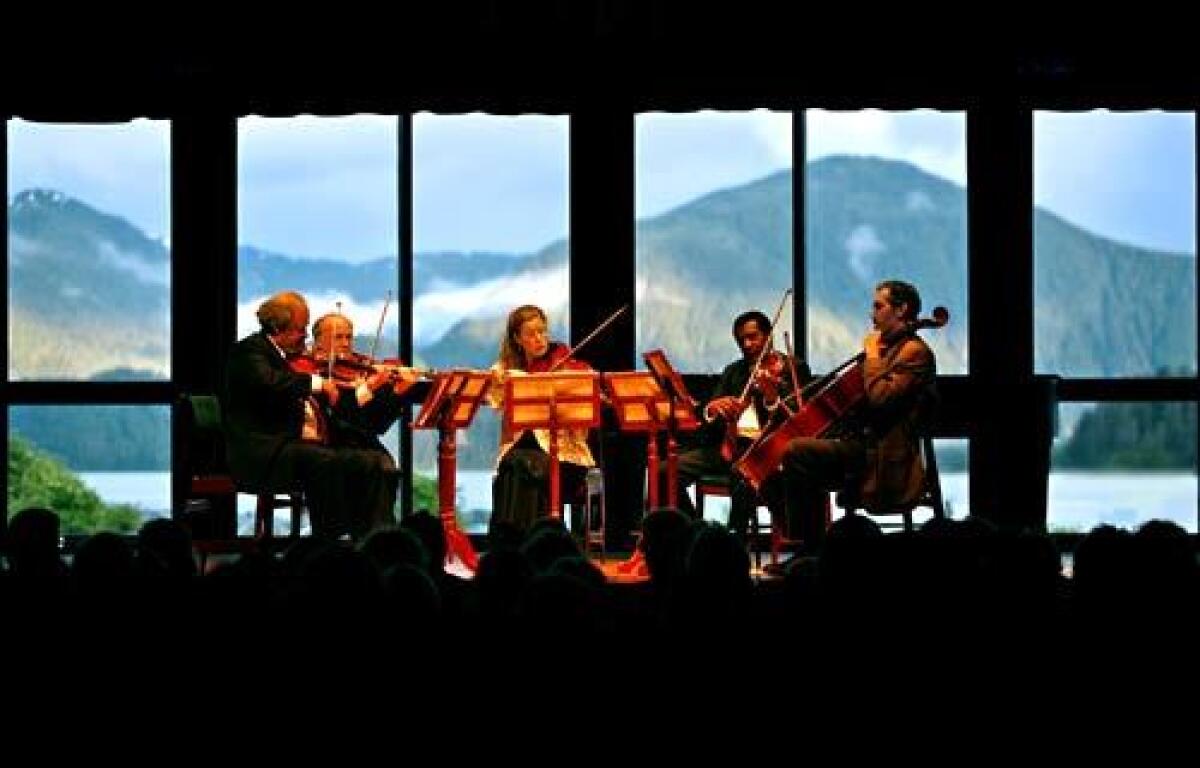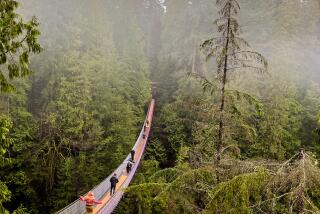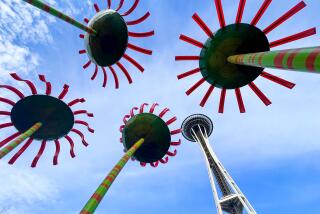Sitka, where woodwinds and Alaska wildlife put on a show

- Share via
The small red plastic sign on the wall behind the Avis car-rental counter set off alarm bells in my brain: “A cleaning fee may be charged due to fish smell or having animals in the car or trunk.”
FOR THE RECORD:
Airfare to Alaska: An information box accompanying a Travel article Sunday on Sitka’s summer music festival incorrectly reported the restricted round-trip airfare from LAX to Sitka. Connecting service (change of planes) on Alaska Airlines begins at $714. —
Now I understood why the heads of long-dead animals adorned the walls of Sitka’s airport terminal and why all those men on the flight from Seattle wore plaid wool shirts. People come to southeast Alaska to kill things. I lost interest in fishing long ago. I get my meat from the market rather than gunning it down in the woods. The odd man out, I had come to eat salmon and halibut, shoot photos of wildlife and listen to classical music.
Musical interlude
Violinist Paul Rosenthal visited Sitka in 1972. He thought it would be an ideal place to hold an informal reunion with fellow musicians, so he raised money to fly them in and stage the town’s first Summer Music Festival. They performed without pay; proceeds from ticket sales barely covered their return flights. Each year since, 18 to 35 professional musicians from throughout the world come to Sitka for three weeks in June to make music as beautiful and dramatic as the scenery.
It was standing room only at the Friday evening concert I attended last year. Just beyond the floor-to-ceiling glass wall at the rear of the stage, bald eagles swooped across the waters of mountain-encircled Crescent Bay. Five of the eight musicians had performed at a noontime brown bag performance the day before, including Armen Ksajikian, a bearded bear of a man who came to the U.S. from the Soviet Union in 1976. He could have been a reincarnated resident of New Archangel, the name the Russians gave the town when they ran the place in the 19th century.
Waiting for the tour boat Saint Michael to cast off before the Boat Party Concert the next evening, I trained my binoculars on the gray waters of Sitka harbor and watched gigantic Steller sea lions have a seafood feast just beyond the marina entrance. Wine flowed, and a picnic dinner was served during a half-hour sail north to uninhabited Cedar Cove. The entrancing strains of a Mozart quintet for strings floated through the cabin. No other vessels intruded into the tranquil anchorage.
A light rain fell, small fish jumped on the surface of the lake-like bay, and little brown birds buzzed the boat like feathered bumblebees. After an hour bobbing along to the music, it was time for dessert. As the catamaran whisked me back to town in mid-evening, I sipped hot chocolate laced with peppermint schnapps while the cloud-veiled Midnight Sun hung high in the sky over Sitka Sound.
The Russians are coming and going
The Russians arrived here in 1799 with a single-minded purpose: Whack sea otters over the head and take their pelts home to be made into furry products. Three years later, the native Tlingit clan killed most of these European invaders and sent the rest packing.
In 1804, the Russians returned in force. Native Aleuts from farther north were pressed into being accomplices to retribution. Realizing they were outgunned, the Tlingits melted into the forest. Seventeen years later, the Russians invited them to return and live under an uneasy truce.
By 1867, the fur trade had wound down and Czar Alexander II unloaded Alaska for $7.2 million to what appeared to be a gullible buyer: U.S. Secretary of State William H. Seward. At Sitka, Capt. Alexei Pestchourof handed over the keys to Alaska to U.S. Army Gen. L.H. Rousseau, put on a fur hat, said, “It’s been nice doing business with you,” packed up the vodka and headed home with most of his countrymen. When gold was discovered in the Klondike 30 years later, “Seward’s Folly” looked like “Seward’s Find.”
Reliving history
The twin domes of the Russian Orthodox St. Michael’s Cathedral dominate downtown Sitka. It was built in 1848, destroyed by fire in 1966 and rebuilt. Tiny compared with the great cathedrals of Europe, St. Michael’s is nonetheless filled with beautiful religious icons saved from destruction in the fire. Docents offer tours during limited hours on weekdays, but the church is closed on weekends for services.
From the cathedral, you can take a walking tour of town with stops at Castle Hill (where the Russians transferred Alaska to the U.S.), the 1934 Alaska Pioneer Home, a Russian blockhouse replica and the nearby Lutheran Cemetery and its poorly maintained Russian cousin. The Russian Bishop’s House, one of only four structures in the U.S. dating to the period of Russian occupation, is a museum on the east side of downtown operated by the U.S. National Park Service.
Sitka National Historical Park sits on the edge of Jamestown Bay, where the Russians defeated the locals in the big battle of 1804. The park has a fine visitor center with exhibits on Tlingit culture, and it has workshop areas where Tlingit artisans carve wood, weave fabrics and create beadwork. Totem poles line a short, shady path.
Fly like an eagle
In southeast Alaska, bald eagles are almost as common as crows in the Lower 48. You can see them up close at Sitka’s Alaska Raptor Center. Birds of prey that have undergone surgery can flex their wings in the indoor “Flight Training Center” before being released into the wild. During my visit, a young staff member entered the center’s lobby with a huge eagle on his arm. I grabbed a front-row seat for a short audience with Sitka the eagle, who cast a jaundiced eye on me from just a few feet away.
A walk in the woods
There are several day hikes in the Sitka area. At Mosquito Cove, I encountered only a couple of those nasty insects during a walk along a shoreline bordering a lush forest of fern and cedar. Then I strolled along a boardwalk at the edge of a marsh where a stream spills into Sitka Sound. When I mentioned to a local packing a pistol on her hip that her huge black Lab was as big as a bear, she told me that on a recent day she had seen such an ursine critter nearby. I bid her good day, quickly walked to my rental car and got out of there.
But I returned a couple of days later and ambled down the boardwalk to a salmon-spawning stream. It was too early in the season to see the fish, but I spotted a very colorful warbler, passed a half-dozen or so other hardy souls braving the drizzly weather and then looped back to the car without becoming a big, bad bear’s lunch.
More to Read
Sign up for The Wild
We’ll help you find the best places to hike, bike and run, as well as the perfect silent spots for meditation and yoga.
You may occasionally receive promotional content from the Los Angeles Times.






